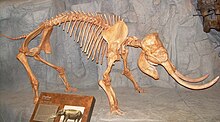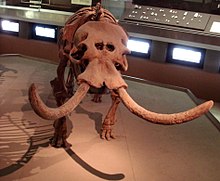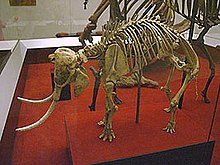Dwarf elephant

Dwarf elephants are prehistoric members of the order Proboscidea which, through the process of allopatric speciation on islands, evolved much smaller body sizes (around 1.5–2.3 metres (4 ft 11 in–7 ft 7 in)) in comparison with their immediate ancestors. Dwarf elephants are an example of insular dwarfism, the phenomenon whereby large terrestrial vertebrates (usually mammals) that colonize islands evolve dwarf forms, a phenomenon attributed to adaptation to resource-poor environments and selection for early maturation and reproduction. Some modern populations of Asian elephants have also undergone size reduction on islands to a lesser degree, resulting in populations of pygmy elephants.
Fossil remains of dwarf elephants have been found on the Mediterranean islands of Cyprus, Malta (at Għar Dalam), Crete (in Chania at Vamos, Stylos and in a now-underwater cave on the coast), Sicily, Sardinia, the Cyclades Islands and the Dodecanese Islands. Other islands where dwarf Stegodon have been found are Sulawesi, Flores, Timor, other islands of the Lesser Sundas and Central Java; all of these islands are in Indonesia. The Channel Islands of California once supported a dwarf species descended from Columbian mammoths,[1] while populations of small woolly mammoths were once found on Saint Paul Island; the mammoths that existed on Wrangel Island are no longer considered dwarfs.
The Mediterranean islands[]

Dwarf elephants first inhabited the Mediterranean islands during the Pleistocene, including all the major islands with the apparent exception of Corsica and the Balearics. Mediterranean dwarf elephants have generally been considered as members of the genus Palaeoloxodon, derived from the continental straight-tusked elephant, Palaeoloxodon antiquus (Falconer & Cautley, 1847), Syn.: Elephas antiquus. An exception is the dwarf Sardinian mammoth, Mammuthus lamarmorai (Major, 1883), the first endemic elephant of the Mediterranean islands recognized as belonging to the mammoth line. A genetic study published in 2006 theorized that the Elephas creticus could be from the mammoth line too. A scientific study of 2007 demonstrates the mistakes of the DNA research of 2006.[3]
During low sea levels, the Mediterranean islands were colonised again and again, giving rise, sometimes on the same island, to several species (or subspecies) of different body sizes. As the Ice Age came to an end, sea levels rose, stranding elephants on the island. The island of Sicily appears to have been colonised by proboscideans in at least three separate waves of colonisation. These endemic dwarf elephants were taxonomically different on each island or group of very close islands, like the Cyclades archipelago.
There are many uncertainties about the time of colonisation, the phylogenetic relationships and the taxonomic status of dwarf elephants on the Mediterranean islands. Extinction of the insular dwarf elephants has not been correlated with the arrival of humans to the islands. Furthermore, it has been suggested by the palaeontologist Othenio Abel in 1914,[4] that the finding of skeletons of such elephants sparked the idea that they belonged to giant one-eyed monsters, because the center nasal opening was thought to be the socket of a single eye, and thus perhaps were, for example, the origin of the one-eyed Cyclopes of Greek mythology.
Italy and Malta[]

| Island | Taxon | Author |
|---|---|---|
| Sardinia | Mammuthus lamarmorai | (Major, 1883) |
| Favignana | Palaeoloxodon species | Palombo et al., 2020[5] |
| Malta | Palaeoloxodon falconeri | (Busk, 1869) |
| Palaeoloxodon mnaidriensis | (Adams, 1874) | |
| Sicily | Palaeoloxodon falconeri | (Busk, 1869) |
| Palaeoloxodon mnaidriensis | (Adams, 1874) |
Greece[]
Crete[]

| Island | Taxon | Author |
|---|---|---|
| Crete | Mammuthus creticus | (Bate, 1907) |
| Palaeoloxodon chaniensis | (Symeonides et al., 2001)[6] | |
| (Kuss, 1965) |
Poulakakis and others proposed in 2002 to rename all the described specimens of larger size than Mammuthus creticus under the new subspecies name Elephas antiquus creutzburgi (Kuss, 1965).[7] After DNA research, published in 2006, it has been proposed to rename Elephas (Palaeoloxodon) creticus into Mammuthus creticus (Bate, 1907). In a recent study of 2007, it was argued for the groundlessness of the theory by Poulakakis et al. in 2006,[8] showing the weak points of that DNA research.[3] However, morphological data is at least equivocal, and may also support placement in Mammuthus.
Cyclades[]
| Island | Taxon | Author |
|---|---|---|
| Delos | Palaeoloxodon sp. | Vaufrey, 1929 |
| Naxos | Van der Geer et al., 2014[9] | |
| Paros | Elephantidae indet. | Georgalas, 1929 |
| Kythnos | Elephantidae indet. | Honea, 1975 |
| Milos | Elephantidae indet. | Papp, 1953 |
| Serifos | Elephantidae indet. | Papp, 1953 |
Remains of paleoloxodontine elephants have been reported from several Cyclades islands. The Delos elephant's size is comparable to Palaeoloxodon mnaidriensis.[9] The Naxos elephant has been described as Palaeoloxodon lomolinoi and it was smaller than the Delos elephant with a calculated body mass of only 10 % of that of its mainland ancestor Palaeoloxodon antiquus.[9]
Dodecanese[]

| Island | Taxon | Author |
|---|---|---|
| Astypalaia | Palaeoloxodon sp. | Athanassiou et al., 2019[2] |
| Kasos | Palaeoloxodon aff. creutzburgi | Sen et al., 2014[11] |
| Rhodes | Palaeoloxodon sp. | Symeonides et al., 1974 |
| Tilos | (Theodorou et al. 2007)[12] |
On the island of Rhodes, bones of an endemic dwarf elephant have been discovered. This elephant was similar in size to Palaeoloxodon mnaidriensis.
Two groups of remains of dwarf elephants have been found on the island of Tilos. They are similar in size to Palaeoloxodon mnaidriensis and the smaller Palaeoloxodon falconeri, but the two groups indicate sexual dimorphism.[13][14] The remains had originally been designated to Palaeoloxodon antiquus falconeri (Busk, 1867). However, this name refers to the dwarf elephants from the island of Malta. As a result, since no migration route between the two islands can be proved, this name should not be used when referring to the elephant remnants from Tilos. The species has been described as Elephas tiliensis in 2007[12] and it is now assigned to genus Palaeoloxodon.
The Tilos dwarf elephant is the first dwarf elephant whose DNA sequence has been studied. The results of this research are consistent with previous morphological reports, according to which Palaeoloxodon is more closely related to Elephas than to Loxodonta or Mammuthus.[15] On the other hand DNA analysis in 2017 conclude that the closest living relative oft the genus Palaeoloxodon is the African forest elephant (Loxodonta cyclotis).[16] The paper suggests that the current view of elephant evolution is „in need of substantial revision“.[16] After the study of new osteological material[12] that has been excavated in anatomical connection in the Charkadio Cave on Tilos island the new species name Palaeoloxodon tiliensis has been assigned to the Tilos dwarf elephants. It was the latest paleoloxodontine to survive in Europe. They did not become extinct until around 4000 BC, so this elephant survived well into the Holocene. An exhibition is available at the Municipality of Tilos Island, soon to be transferred to the new building near Charkadio Cave.
Cyprus[]
| Island | Taxon | Author |
|---|---|---|
| Cyprus | Palaeoloxodon cypriotes | (Bate, 1903)[17] |
| Athanassiou et al., 2015[18] |
The Cyprus dwarf elephant survived at least until 11,000 BC. Its estimated body weight was only 200 kg (440 lb), only 2% of its 10,000 kg (22,000 lb) ancestor. Molars of this dwarf elephant are reduced to approximately 40% the size of mainland straight-tusked elephants.
Remains of the species were first discovered and recorded by Dorothea Bate in a cave in the Kyrenia hills of Cyprus in 1902 and reported in 1903.[17][19]
The Channel Islands of California[]
The Columbian mammoth (Mammuthus columbi) produced a separate, isolated population at the end of the Pleistocene on the Channel Islands of California, most likely about 40,000 years ago (although the time of isolation is not fully known). Selective forces on the Channel Islands resulted in smaller animals, forming a new species, the pygmy mammoth (Mammuthus exilis).[20] Channel Islands mammoths ranged from 150–190 cm (59–75 in) in shoulder height.
St. Paul Island and Wrangel Island[]
Mammoths also survived longer on Saint Paul Island in the Bering Sea until 6000 BC.[21] Survival of a mammoth population may be explained by local geographic, topographic and climatic features, which entailed preservation of communities of steppe plants, as well as a degree of isolation sufficient to delay colonization by humans. St. Paul Island shares this characteristic of geographic isolation, implying that human hunting may have played a role in the disappearance of the woolly mammoth.
During the last ice age, woolly mammoths (Mammuthus primigenius) lived on Wrangel Island in the Arctic Ocean and survived until 1700 BC, the most recent survival of any known mammoth population. Wrangel Island is thought to have become separated from the mainland by 12000 BC. It was assumed that Wrangel Island mammoths ranged from 180–230 cm (71–91 in) in shoulder height and were for a time considered "dwarf mammoths".[22] However this classification has been re-evaluated and since the Second International Mammoth Conference in 1999, these mammoths are no longer considered to be true "dwarf mammoths".[23]
Indonesia[]
On Sulawesi and Flores, evidence of a succession of distinct endemic island faunas has been found, including dwarfed elephants, dating until the Middle Pleistocene. Around the Early Middle Pleistocene, these dwarfed elephants were replaced by new immigrants of larger to intermediate sizes.
Flores[]
The present understanding of the succession of Stegodon species on Flores is that endemic dwarfs, represented by the Early Pleistocene species Stegodon sondaarii, became extinct around 840,000 years ago. These dwarf forms were then replaced by the medium to large-sized Stegodon florensis, a species closely related to the Stegodon trigonocephalus group found both in Java and in the islands of biogeographical Wallacea, separated by deep water from the Asian and Australian continental shelves. This Stegodon species became extinct about 12,000 years ago, presumably because of a volcanic eruption.
Sulawesi[]
The dwarfed Stegodon sompoensis lived during the Pleistocene on the island of Sulawesi. They had a shoulder height of only 1.5 m.
Central Java[]
In 2014 a dwarf elephant was found in the Semedo area, Tegal, Central Java, so it was named Stegodon semedoensis.[24]
See also[]
References[]
- ^ "The Pygmy Mammoth (U.S. National Park Service)".
- ^ Jump up to: a b Athanassiou, A.; Van der Geer, A. A. E.; Lyras, G. A. (2019). "Pleistocene insular Proboscidea of the Eastern Mediterranean: A review and update". Quaternary Science Reviews. 218: 306–321. doi:10.1016/j.quascirev.2019.06.028.
- ^ Jump up to: a b Orlando, L.; Pagés, M.; Calvignac, S.; et al. (2007-02-22). "Does the 43bp sequence from an 800000 year old Cretan dwarf elephantid really rewrite the textbook on mammoths?". Biology Letters. 3 (1): 57–59. doi:10.1098/rsbl.2006.0536. PMC 2373798. PMID 17443966.
- ^ Abel's surmise is noted by Adrienne Mayor in The First Fossil Hunters: Paleontology in Greek and Roman Times (Princeton University Press) 2000. [See illus. ed., 2001: ISBN 0691089779]
- ^ Jump up to: a b Palombo, M. R.; Antonioli, F.; Di Patti, C.; Presti, V. L.; Scarborough, M. E. (2020). "Was the dwarfed Palaeoloxodon from Favignana Island the last endemic Pleistocene elephant from the western Mediterranean islands?". Historical Biology: 1–19. doi:10.1080/08912963.2020.1772251.
- ^ Symeonides, N. K.; et al. (2001). "New data on Palaeoloxodon chaniensis (Vamos cave, Chania, Crete) Archived June 26, 2006, at the Wayback Machine". In Cavarretta, Giuseppe (ed.), The World of Elephants - International Congress, Rome 2001, Rome 2001, 510-513. ISBN 88-8080-025-6
- ^ Poulakakis, N.; Mylonas, M.; Lymberakis, P.; and Fassoulas, C. (2002-10-01). "Origin and taxonomy of the fossil elephants of the island of Crete (Greece): problems and perspectives". Palaeogeography, Palaeoclimatology, Palaeoecology. 186 (1–2): 163–183. doi:10.1016/S0031-0182(02)00451-0.
- ^ Poulakakis N.; Parmakelis A.; Lymberakis P.; Mylonas M.; Zouros E.; Reese D.; Glaberman S.; Caccone A. (2006). "Ancient DNA forces reconsideration of evolutionary history of Mediterranean pygmy elephantids". Biol. Lett. 2 (3): 451–454. doi:10.1098/rsbl.2006.0467. PMC 1686204. PMID 17148428.
- ^ Jump up to: a b c d Van der Geer, A. A. E.; Lyras, G. A.; Van den Hoek Ostende, L. W.; De Vos, J.; Drinia, H. (2014). "A dwarf elephant and a rock mouse on Naxos (Cyclades, Greece) with a revision of the palaeozoogeography of the Cycladic Islands (Greece) during the Pleistocene". Palaeogeography, Palaeoclimatology, Palaeoecology. 404: 133–144. doi:10.1016/j.palaeo.2014.04.003. hdl:10795/3263.
- ^ Masseti, M. (2008). The most ancient explorations of the Mediterranean. Proc. Calif. Acad. Sci. 4th Ser, 59(Suppl I), 1-18.
- ^ Sen, S.; Barrier, E.; Crété, X. (2014). "Late Pleistocene Dwarf Elephants from the Aegean Islands of Kassos and Dilos, Greece". Annales Zoologici Fennici. 51: 27–42. doi:10.5735/086.051.0204.
- ^ Jump up to: a b c Theodorou, G.E.; Symeonides, N.; Stathopoulou, E. (2007). "Elephas tiliensis n. sp. from Tilos island (Dodecanese, Greece)". Hellenic Journal of Geosciences. 42: 19–32.
- ^ Theodorou, G. (1983). The dwarf elephants of the Charkadio cave on the island of Tilos (Dodekanese, Greece). Phd Thesis Athens University. p. 321 pp.
- ^ Theodorou, G.E. (1988). "Environmental factors affecting the evolution of islands endemics: The Tilos example for Greece". Modern Geology. 13: 183–188.
- ^ Poulakakis, Nikos; Theodorou, Georgios E.; Zouros, Eleftherios; Mylonas, Moysis (2002-09-01). "Molecular Phylogeny of the Extinct Pleistocene Dwarf Elephant Palaeoloxodon antiquus falconeri from Tilos Island, Dodekanisa, Greece". Journal of Molecular Evolution. Springer Science and Business Media LLC. 55 (3): 364–374. doi:10.1007/s00239-002-2337-x. ISSN 0022-2844. PMID 12187389.
- ^ Jump up to: a b Meyer, Matthias; Palkopoulou, Eleftheria; Baleka, Sina; Stiller, Mathias; Penkman, Kirsty E H; Alt, Kurt W; Ishida, Yasuko; Mania, Dietrich; Mallick, Swapan; Meijer, Tom; Meller, Harald; Nagel, Sarah; Nickel, Birgit; Ostritz, Sven; Rohland, Nadin; Schauer, Karol; Schüler, Tim; Roca, Alfred L; Reich, David; Shapiro, Beth; Hofreiter, Michael (6 June 2017). "Palaeogenomes of Eurasian straight-tusked elephants challenge the current view of elephant evolution". eLife. 6: e25413. doi:10.7554/eLife.25413. PMC 5461109. PMID 28585920.
- ^ Jump up to: a b Bate, D. M. A.: Preliminary Note on the Discovery of a Pigmy Elephant in the Pleistocene of Cyprus in Proceedings of the Royal Society of London Vol. 71 (1902 - 1903), pp. 498-500
- ^ Athanassiou, A.; Herridge, V.; Reese, D. S.; Iliopoulos, G.; Roussiakis, S.; Mitsopoulou, V.; Tsiolakis, E.; Theodorou, G. (2015). "Cranial evidence for the presence of a second endemic elephant species on Cyprus". Quaternary International. 379: 47–57. doi:10.1016/j.quaint.2015.05.065.
- ^ Dorothea Bate, Cyprus work diary 1901–02, 3 volumes, Natural History Museum's earth sciences library, palaeontology MSS
- ^ Rocha, Veronica (16 September 2016). "Well-preserved mammoth skull unearthed on Channel Islands puzzles scientists". Los Angeles Times. Retrieved 24 September 2016.
- ^ Guthrie, R. Dale (2004-06-17). "Radiocarbon evidence of mid-Holocene mammoths stranded on an Alaskan Bering Sea island". Nature. Nature Publishing Group. 429 (6993): 746–749. doi:10.1038/nature02612. PMID 15201907.
- ^ Vartanyan, S.L.; Garutt, V.E.; Sher, A.V. (1993). "Holocene dwarf mammoths from Wrangel Island in the Siberian Arctic". Nature. 362 (6418): 337–340. doi:10.1038/362337a0. PMID 29633990.
- ^ Tikhonov, Alexei; Larry Agenbroad; Sergey Vartanyan (2003). "Comparative analysis of the mammoth populations on Wrangel Island and the Channel Islands". Deinsea. 9: 415–420. ISSN 0923-9308. Archived from the original on 2012-06-11.
- ^ Agus Maryono (December 1, 2014). "Fossils of rare, ancient animals found in Tegal".
- Prehistoric elephants
- Holocene extinctions
- History of Sardinia
- History of Sicily
- Maltese prehistory
- Prehistoric Crete
- Prehistoric Cyprus
- Cyclades
- Dodecanese